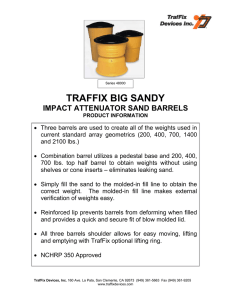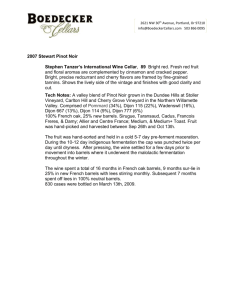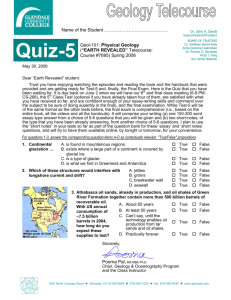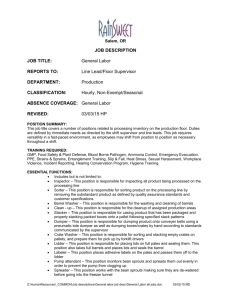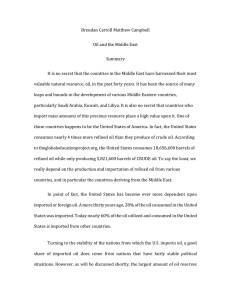N M COMPARATIVE TESTS OF WHITE OA K AND DOUGLAS FIR [ARMS
advertisement
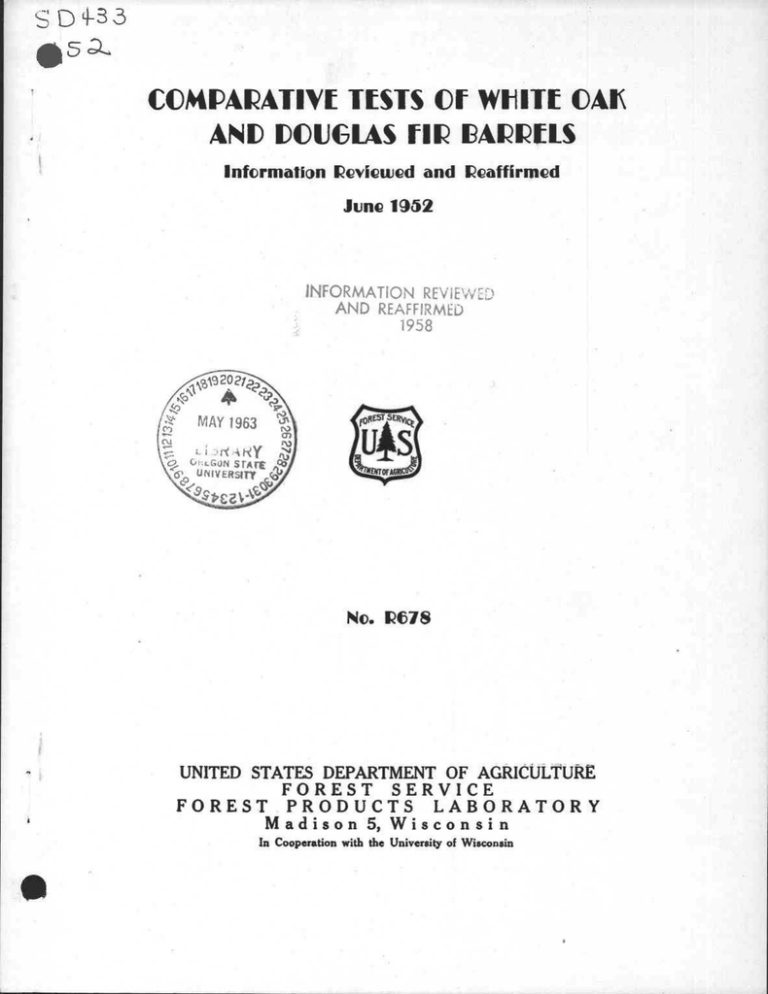
COMPARATIVE TESTS OF WHITE OA K AND DOUGLAS FIR [ARMS Information Revicuied and IZeaffiripe.d June 195 2 INFORMATION REVIEWE D AND REAFFIRME D 195 8 \gin 20 ?lee M MAY 19&3 Cu 3 N m Po o srarE AT (n GoN UNIVERSITY 4acO No. 8678 UNITED STATES DEPARTMENT OF AGRICULTURE FOREST SERVIC E FOREST . PRODUCTS LABORATOR Y Madison 5, Wisconsi n In Cooperation with the University of Wisconsi n • .. I ' i COMPARATIVE TESTS O WHITE - OAX- AIVD DOtLAS%rM. 7 . I. T . , R. C . WILSO N Engineer in Forest Products Z Forest Products Laboratory, Forest Servic e U. S . Department of Agricultur e This report is a comparative summary of two series of tests performed at th e U. S . Forest Products Laboratory, Madison, Wis . -- one on Douglas-fi r -barrels, conducted during March, 1921, and the other on white oak barrels , conducted several years earlier and first reported in U. S . Department o f Agriculture Bulletin No . 86. The oak barrels, furnished by the St . Louis (Mo .) Cooperage Co ., were 48 i n number and were divided into ' six. groups of eight,' as' follows : Group No . 1 of 5/8-inch stock, with 6 : hoops group No . 2, 5/8-inch stock,' 8. ,hoops; grou p No . 3, .3/4-inch stock,- 6 hoops ; group No. 4, 3/4 .-ine'h stock ; '8 hoops ; group No . 5, 7/8-inch stock, --6 hoops ;. .group No . 6, 7(8-inch stock,' 8' hoops . Th e material was quarter-sawed white oak, practically straight grained, and Ares . from defects . The barrels were of excellent workmanship and were wel l coated with paraffin•inside : ' .The staves varied 'in width from about 2-1/ 2 inches to about 7 i#iches . The heads were as a rule . col posed of four piece s joined together with 6-1/6-inch hickory_clowels . Time heads were composed pf three pieces each. The Douglas-fir barrels, furnished by the Western Cooperage Co . , o f Portland, Oref , were 33 in number' and were divided into three groups o f eleven, which the company in their forwarding letter described in the following terms : "The stock in these packages is sawn from No . 1 -Douglas-fi r timber and represents our No . 1 grade 3/4-inch oil staves and our No . 1 grade 20-7/16-inch heading in 3/4-and 15/16-inch thickness . There are t o be 33 barrels forwarded to Madi$o'n ..• . Eleven of these are hooped with' 6 hoop s and headed with 3/4-ifch head ; 11 are . hooped with 8 hoops andheaded wit h 3/4-inch heads ; and the balance are ho ;-iced with 8 hoops and headed with 15/16-inch heads . All hea'dinns used in these packages'have - glued joints , and the packages' were setfrom_average stock the same as received fro m our mill, there 'being no special 'selecting . " published in the West Coast Lumberman, V48, No . 566, May 1, 1925 . ?Maintained at Madison, Wis . , in cooperation with the University of Wisconsin . Rept . No . 678 -_ -l- M Agriculture-Madison The barrels, of both species, after being completely filled with water , were subjected to the following tests : Side compression, diagonal compression, internal pressure, side drop, and diagonal drop. Some barrel s of each group and each species were subjected to each kind of test . Th e results will be briefly discussed in the succeeding paragraphs and th e general conclusions stated . Oak Barrel s In each kind of test the first water to appear on the outside of the barre l was usually from seepage lengthwise through the pores of the wood at th e chime . The first leak usually occurred wither between the staves and th e head or between the staves-at the chime. In all the tests except internal , pressure the first leak was usually coincident with the slipping of th e staves . In the internal-pressure test there were two general classes of failures : (1) By springing and breaking of_the head ; and '(2) by leaking between th e staves at the bilge . In the diagonal-compression-test the failure was a general failure of the head combined with slipping of the staves . In the side-compression tes t the failure was a general leaking at the heads and slipping} of the stave s followed by the breaking of the staves at the bilge . In the side-drop test the slipping of the staves caused loosening of hoops and leakage at heads, followed by breaking of the staves at the bilge . ;ri■ three of the six barrels thus tested, failure was due to the heads being broken or forced out by the pressure produced ; The impact. The lower heads of all barrels tested by dropping on the Chime were broken or forced out by-the pressure-due tot the-i , Douglas-fir Barrel s First leakage in nearly all tests of Douglas-fir barrels developed in on e of two ways : (1) By water passing completely around the edge of the hea d and appearing in the angle between the head and the chime, or (2) by wate r passing partially around the edge of the head and thence through the pore s and appearing as small drops on the edge of the chime . Leakage of th e first type is described as "leakage at craze, " and the second as "seepag e through chime . " There were very few instances in whicli leakage betwee n the staves occurred except after the barrel had been quite severel y deformed as in the side and diagonal-compression tests . In the diagonal compression tests_ leakage - crushing at the edge of the head occurred Rcpt . No .. 678 -2- at a , fairly early stage ., As a special test, barrel No . . .as g o pk that the end grain of the head came at the point of press'A .-, and l e did not occur until a considerably higher load was reach e Aside from the first leakage, types of failures differed wkind of test . ^; :Y ` Ft LN .I , In side and diagonal-compression, later failures were by slipping i n ptave joints and shear or splitting of staves, combined with opening o f the joint between staves and head and splitting of head . In this test ther e were numerous instances in which staves split or sheared for their entir e length . In fact, it seemed to be almost as easy for such shearing t o occur as for staves to slip on each other at the joints . This was true also in side and diagonal-drop tests , Final failure in side and diagonal-drop, tests was the driving out of th e head by the shock of the contents . Final failure in internal-pressure tests was by breaking or bursting ou t of the heads . Comparison of White Oak and Douglas-fir Barrel s At first leak in side compression, the Douglas-fir barrels take only abou t two-thirds of the load carried by the white oak barrels . The white oa k barrels, however, begin leaking at a much smaller deformation than do the Douglas-fir, and the product of load and deflection at first leak is in ever y case of comparison higher .for Douglas-fir than for white oak . These fact s indicate that when subjected to shocks against the bilge, the Douglas-fi r barrels, although they develop less resistance before leakage, yield muc h more (or farther) and can absorb fully as great a shock as the white oak . It should be noted in this-connection that a common practice is to store o r stow barrels on their sides with the bottom row blocked at the quarters an d upper rows laid in the "cantlines, " or space between barrels of the r'o w below, and with the bilges above the heads of the row below . It is to b e expected that barrels so arranged will sustain considerably larger loads than we're developed in the side comprssion test . At first leak in diagonal compression, Douglas-fir barrels take less load than white oak barrels . Here again, however, white oak barrels stand muc h less deformation than the Douglas-fir, with the result that shock-resistanc e as indicated by product of load and deflection is practicta.l, l,&g. of the. two species . .LP, ■. ,. The height of drop (both side and diagonal) for DouglaslIfO barrel' at fir ;o leak averages about three-fourths as much as for I.W1044ppit4'.. jtApprox ' ' ..~.- w-.t' j Rept_ No, 678 -3H1 = the same ratio applie s, to 'height of drop to produce leakage at the rat e of one pound of water per minute . When .subjected' to internal water pressure the Douglas-fir barrels . develop two to three times as great pressure at first leak as do-th e white oak barrels . . The pressure require- to produce leakage at th e 'rate of 1 pound of water•per minute averages about $e0 percent higher fo r Douglas-fir than for white oak. Discussion and Conclusions The following conclusions apply only to white oak and Douglas-fir 'barrel s having the-combination of number, quality, and .dimensions of hoops an d thicknesses of staves and heads represented in the -tests and .describe d herein : 1. .In the oak barrels, increase in' thickness of stave is of much less valu e than increase in head thickness, and it is to be expected that oak barrel s with 5/8-inch staves and. 7/8-inch or 15/16-inch heads will prove fully a s -serviceable under ordinary conditions as barrels, with 7/8-inch staves and , 7/8-inch heads . 2. In Douglas-fir., barrels with_i5j16-inch"heads and 3/4-inch staves ar e somewhat superior in resistance-to internal pressure to 'barrels with' 3/4-inch heads and staves : 3. When there 'is little change' mois =ture content of , the. wood; as in these ' tests, the eight-hoop barrels .show but little superiority over six-hoop . h When barrels are subjected alternately to moist and dry' conditions, wit the consequent tendencies of the staves to swell-and-shrink, it is to 'be expected that the advantage of the eight-hoop barrels . will be enhanced . 4. When barrels of both species are well and carefully made of properl y selected stock, they compare as follows : Douglas-fir barrels have about two-thirds as great resistance as hav e white oak barrels to leakage under -steady loads, as in the bottom o f storage piles . The Douglas-fir barrels, however, probably have suffici. ent resistance to carry safely such loads'as are at all likely to come on them in storage or shipment .' , The Douglas-fir barrels, moreover, can b e deformed to a'greater extent without' leakage. than can the white oak . Resistance to shock is proportional to the product of load and deformation . Douglas-fir and white oak barrels are practically equal in this respect, . a . fact indicating that when loaded on end in railway cars they may be expecte d to withstand equal shocks without leaking . After leakage has begun, how ever, the steady force and the shock required to cause increased leakag e are greater for white oak than for Douglas-fir barrels . Rcpt . No . 678 -4- 1 When dropped upon the chime-or upon the bilge, the D~o;;r 4a -.f ar ~l;s withstand without leakage about 25 percent lower . drops than white oak, indicating somewhat greater susceptibility' to damage from 'roug h handling in rolling or sliding down skids . The Douglas-fir barrels withstand from two to three times as muc h internal pressure before leaking as do the white oak barrels . 5 . The Douglas-fir barrels tested were made with 17-gauge by:l-3/4-inc h and 18-gauge by 1-1/2-inch hoops in order to have them uniform in thi s respect with the oak barrels . tested, and also to comply with I . C . C . specification No . 10 . As Douglas-fir is softer and exerts less force in swelling than oak, it is not certain that these sizes are necessary . Furthe r tests would be required to determine the safe and most economical size of hoops for Douglas -fir bar*ls . In connection with these comparisons of white oak and Douglas-fir barrel s it is to be remembered that all the barrels tested were of selected stoc k and well manufactured . The oak staves and heading were white oak,- whic h is much more resistant than red oak to penetration by liquid-s . Because of this quality and other properties, such as great stability of form and shap e under changing moisture conditions and greater resistance to decay, whit e oak clear of sapwood is recognized as much superior to red oak for barre l making . The Douglas-fir barrels were from timber- selected for it specialutbyforelmanuct . These points are mentioned ' to bring out the fact that the barrels tested were such as can be n ade onl y through careful attention to selection of timber and to manufacturing _ details, and that the barrels were of comparable quality in their respective species . H 'i The results of the tests lead to the conclusion that with carefully selecte d timber and carefully manufactured barrels, white oak will excel Douglas fir barrels in serviceability under ordinary shipping conditions . If, how ever, the white oak barrels are of indifferently selected stock containin g sapwood or defects, or are carelessly manufactured, they may be expecte d to render much poorer service than Douglas-fir barrels well made o f properly selected material . Selection and Handling of Material Timber is selected and stock handled with great care by the larger ;riainu = facturexs of-Douglas-fir barrels, and it is well to consider here a :numbe r of points bearing on the making of barrels of the best quality from th e species . These points have been developed from the experience of manufacturers, observation of the barrel tests .describe4- task, a i.es.L , tests of Douglas-fir, and field-observations of the pro ties of the species . Rept . No . 678 75 - II 7 1. It is believed by barrel manufacturers that material of suitabl e character can be secured only from trees grown in the low-lying region s or so-called fog belts . 2. Staves of the Douglas-fir barrels tested had an average of about 2 3 annual growth rings per inch . The minimum number was 7 and the maxi mum 44 . It would be well to require that staves show not less than 8 growth rings per inch . 3. It is recommended that Douglas-fir bolts be converted into staves an d kiln-dried promptly after cutting from the logs, in order to avoid th e rather rapid deterioration that may occur through the checking of shor t bolts in drying. 4. It is of prime importance that the staves be as nearly as possibl e perfectly quarter-sawed or edge-grained . Incipient ring shake or weakness of bond between the annual rings is rather frequently encountered i n Douglas-fir . Where this occurs in a stave having the plane of the annua l rings striking through its axis at angle of less than about 60 degrees wit h its surface, slippage along the rings having such weakness is very likel y to happen . It is recommended that in specifications for tight barrels o f Douglas-fir a limit be set to the deviation from perfect edge grain . The following is suggested as a simple and practical statement of the allowable deviation : "Staves shall be so manufactured that the annual rings at any point d o not deviate from a line perpendicular to the face of the stave by more tha n one-half of the thickness of the stave . " 5. Cutting of staves in the manner recommended has a further advantage , since the shrinkage in width of quarter-sawn stock average's only from one half to two-thirds that of slash-grain material . Barrels made of quarter sawn staves therefore shrink and swell less with change in atmospheri c and moisture conditions and give less trouble with leakage, regardless o f species . Not only strength properties but also the tendency to shrink an d swell are factors that should be considered in estimating the - suitability of a given species for tight cooperage . The shrinkage or swelling o f quarter-sawn stock with change of moisture content is practically the sam e for oak and Douglas-fir . Consequently, it is to be expected that trouble s from this source will be least for the barrels whose staves are most perfectly quarter-sawn . t • Rept . No . 678 -6-
